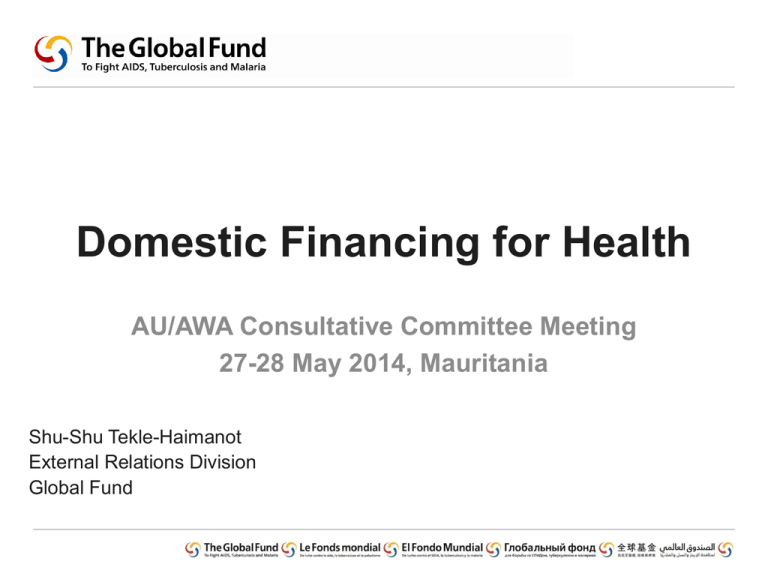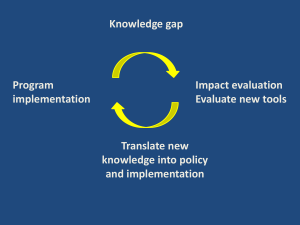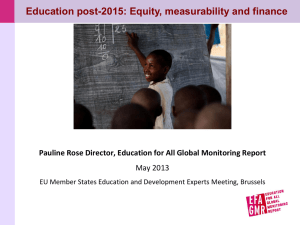Domestic Financing for Health
advertisement

Domestic Financing for Health AU/AWA Consultative Committee Meeting 27-28 May 2014, Mauritania Shu-Shu Tekle-Haimanot External Relations Division Global Fund Background – global health agenda • Unprecedented level of international funding for health from 2002, in particular for AIDS, TB and Malaria through the Global Fund • Investments in health over last 10 years have resulted in significant progress in improving peoples’ lives • Key MDG targets are on track to be achieved in number of African countries, but we need to protect and sustain progress • International Development Assistance is changing • New trends to watch for, particularly in area of support for health Johannesburg March 2014 2 Background – why invest in health? • Economic, social and political benefits from having a healthy nation;citizens have the potential to be more productive and it can lead to demographic dividend • According to the Lancet Commission: “Reductions in mortality account for about 11% of recent economic growth in low and middleincome countries as measured in their national income account” • Governments have an obligation to provide health care - it is a moral imperative! Key question is how and how much should Governments invest. Johannesburg March 2014 3 Key challenges & opportunities • Value for Money: As the resource landscape is changing, focus is now more on improving health programme efficiency and effectiveness which calls for both “more money for health and more health for money” • Domestic Advocacy: a large part of any increase in public funding for health will need to come from governments, therefore need to develop a convincing business and advocacy case for increased public commitment in programs of proven effectiveness • Sustainability: Domestic public spending is set to continue as economic growth continues, however it will not be sufficient to address all the health needs. Therefore, still a need for external resources in the short to medium term. Hence the need to explore innovative domestic financing mechanisms. Johannesburg March 2014 4 Global needs assessment for HIV, TB & malaria for 2014-16 $100B $90B $80B $70B $60B $50B $40B $30B $20B $10B $0B GF donors pledged more than $ 12 B out of $ 15 B target $14B Governments expected to significantly increase investments in HIV, TB and malaria $12B $24B $73B $14B 84% resource needs covered $23B Domestic financing (current levels) Johannesburg $87B March 2014 Additional domestic resources Other external financing Global Fund Total need 5 Global priorities are changing & will have implications on external health financing Post -2015 MDG High Level Panel Report Johannesburg March 2014 6 Africa has made commitments & countries are demonstrating progress • • • • Abuja Declaration on HIV/AIDS, TB and Other Related Infectious Diseases, 2001: Heads of State commit to spend at least 15 % of budgets on Health Addis Ababa, African Union roadmap on shared responsibility and global solidarity for AIDS, TB and malaria response, 2012. AU endorsed Roadmap on Shared Responsibility and Global Solidarity for HIV, TB and Malaria and the Pharmaceutical Manufacturing Plan Tunis Declaration on value for money, sustainability and accountability in the health sector, 2012. Governments commit to enhance value for money, increase accountability, improve sustainability of health resources and fight corruption. Abuja AU Special Summit Declaration on HIV/AIDS, TB and malaria, 2013. Calls for countries to honor the 2001 Abuja Declaration and other health commitments. Johannesburg March 2014 Health as % of total government expenditure, 2011 Rwanda 23.7% Malawi 18.5% Zambia 16.0% Togo 15.4% Tanzania 11.1% South Africa 10.0% Botswana 8.7% Nigeria 7.5% Kenya 5.9% Source: UNAIDS, Oxford Policy Management, Et al. 7 How to determine domestic commitment to health and AIDS,TB and malaria • According to minimum standard? ($44) • What is affordable? • What is cost effective? • Fair share between domestic and donors? • UNAIDS developed Domestic Index of Priority • More money for health and/or more health for money? This is a political decision at both national and international levels. Johannesburg March 2014 8 How countries can sustain effective AIDS, TB and malaria, as well as HSS programs • Increase donor support --► getting more from existing donors or involving new donors • Increase domestic financing -- ► Public or government -- ► Private sector -- ► Out of pocket • Decrease the cost of the current response by improving efficiencies in existing programs And most importantly, PREVENT NEW INFECTIONS Johannesburg March 2014 9 Innovative ways of raising domestic resources and potential gains Source US$ billions 75% of an alcohol levy 3.9 Contributions from high-revenue enterprises 2.4 Airline levy by all African countries 1.7 2% of public sector budgets earmarked for AIDS 2.4 Mobile phone levy 2.0 1% income tax levy earmarked for AIDS 3.1 But how to 1) sell these ideas and 2) ring-fence the funds? Johannesburg March 2014 10 Criteria and considerations for investment in health and AIDS, TB and malaria • Level of national income, GDP or GNI. An approximation of resources available within a country • Degree to which the Government is able to raise revenue through taxes, levies, domestic borrowing, or other means. • Proportion of Government budget devoted to debt • Pre-existing pattern of disbursement to different sectors. For health if historical allocations have been low, infrastructure may be poor reducing the short-run capacity to absorb rapid increases and convert to service delivery. Johannesburg March 2014 11 Plan for analyzing “Fiscal Space” • Macroeconomic analysis --► Evaluating potential resource needs and resource availability, identifying future resource gaps and potential ways of eliminating such financial gaps. • Microeconomic analysis --► Assessing potential opportunities to make the 3 largest interventions more efficient, for e.g. in HIV/AIDS: 1. ART 2. PMTCT 3. OVC Johannesburg March 2014 12 Increased domestic financing (IDF) for health – 2 complementary & mutually reinforcing strategies Take forward the work of domestic financing internally and externally with aim to support countries and drive ownership in domestically financing local public health agenda and to work with key partners such as AU, ADB, WB and others in the advocacy and implementation. Advocacy plan with key messages by Donors, private sector and CSOs GF strategy for increased domestic financing for health Domestic Financing Strategy and support the buy-in process Revive the cochampionships and identify other champions Option of tools/mechanisms for innovative financing Identify key events where to raise domestic financing for health Documentation of Best practices Disseminate best practices Demonstrate progress towards increasing domestic financing in 2 out of 5 priority countries (Tanzania, Ethiopia, Kenya, Senegal, and Malawi) 13 The Global Fund is working with countries and partners to: • Improve data quality and accessibility for both domestic and international health funding • Nurture political leadership --► ongoing work on advocacy and messaging to ensure health remains a top priority at national and international levels • Revisit and raise awareness on economic arguments for health, including how it makes macro-economic sense • Identify and address rigid budgeting practices that are obstacles to the reallocation of revenues towards health • Foster effective dialogue between local health and finance officials --► creating space for discussion by empowering health officials and ensuring that finance has a better understanding of health issues • Recognize and enhance the role of civil society Johannesburg March 2014 14 The Global Fund is working with countries and partners to: • Finally, by addressing the core question “it is possible to define the “right” mix of domestic and international investment in any country” and acknowleding that this “mix” will vary country by country --► Establish an acceptable “benchmark” on a country by country basis for domestic investment in health and the three diseases and develop monitoring and evaluation framework to assess progress. • Ensure UHC is taken into consideration when planning for domestic health care Johannesburg March 2014 15 Conclusions • Health expenditures should keep pace with economic growth • There is no single blueprint for increasing domestic funding for health • Lessons learned and best practices should THANK YOU Johannesburg March 2014 16







